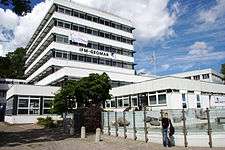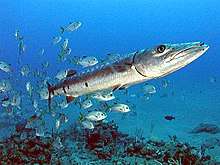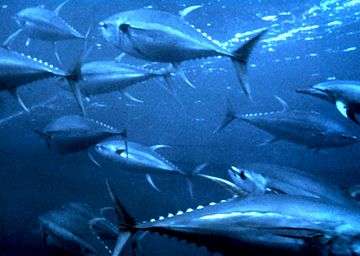FishBase
FishBase is a global species database of fish species (specifically finfish).[1] It is the largest and most extensively accessed online database on adult finfish on the web.[2] Over time it has "evolved into a dynamic and versatile ecological tool" that is widely cited in scholarly publications.[3][4]
 | |
|---|---|
| Content | |
| Description | A large and extensively accessed biological database about fish |
| Data types captured | Comprehensive species data, including taxonomy, biometrics, behaviour, distribution, habitats and photos |
| Organisms | Adult fish species (finfish) |
| Contact | |
| Research center | Leibniz Institute of Marine Sciences, FishBase Consortium coordinator |
| Authors | Daniel Pauly and Rainer Froese |
| Access | |
| Website | www.fishbase.org |
| Tools | |
| Standalone | Historic versions available on CD |
| Miscellaneous | |
| License | CC-BY-NC for data; various levels of licensing for media files (pictures, sounds, ...) to be checked case by case |
| Versioning | Every even month of the year |
| Data release frequency | Continuously updated |
| Version | Last current version: October 2016 |
| Curation policy | FishBase Consortium |
| Bookmarkable entities | Yes |
FishBase provides comprehensive species data, including information on taxonomy, geographical distribution, biometrics and morphology, behaviour and habitats, ecology and population dynamics as well as reproductive, metabolic and genetic data. There is access to tools such as trophic pyramids, identification keys, biogeographical modelling and fishery statistics and there are direct species level links to information in other databases such as LarvalBase, GenBank, the IUCN Red List and the Catalog of Fishes.[5]
As of November 2018, FishBase included descriptions of 34,000 species and subspecies, 323,200 common names in almost 300 languages, 58,900 pictures, and references to 55,300 works in the scientific literature. The site has about 700,000 unique visitors per month.[6]
History
The origins of FishBase go back to the 1970s, when the fisheries scientist Daniel Pauly found himself struggling to test a hypothesis on how the growing ability of fish was affected by the size of their gills.[7] Hypotheses, such as this one, could be tested only if large amounts of empirical data were available.[8] At the time, fisheries management used analytical models which required estimates for fish growth and mortality.[9] It can be difficult for fishery scientists and managers to get the information they need on the species that concern them, because the relevant facts can be scattered across and buried in numerous journal articles, reports, newsletters and other sources. It can be particularly difficult for people in developing countries who need such information. Pauly believed that the only practical way fisheries managers could access the volume of data they needed was to assemble and consolidate all the data available in the published literature into some central and easily accessed repository.[8][10] Such a database would be particularly useful if the data has also been standardised and validated.[8] This would mean that when scientists or managers need to test a new hypothesis, the available data will already be there in a validated and accessible form, and there will be no need to create a new dataset and then have to validate it.[11]
Pauly recruited Rainer Froese, and the beginnings of a software database along these lines was encoded in 1988. This database, initially confined to tropical fish, became the prototype for FishBase. FishBase was subsequently extended to cover all finfish, and was launched on the Web in August 1996. It is now the largest and most accessed online database for fish in the world.[8] In 1995 the first CD-ROM was released as "FishBase 100". Subsequent CDs have been released annually. The software runs on Microsoft Access which operates only on Microsoft Windows.
FishBase covers adult finfish, but does not detail the early and juvenile stages of fish. In 1999 a complementary database, called LarvalBase, went online under the supervision of Bernd Ueberschär. It covers ichthyoplankton and the juvenile stage of fishes, with detailed data on fish eggs and larvae, fish identification, as well as data relevant to the rearing of young fish in aquaculture. Given FishBase's success, there was a demand for a database covering forms of aquatic life other than finfish. This resulted, in 2006, in the birth of SeaLifeBase.[8] The long-term goal of SeaLifeBase is to develop an information system modelled on FishBase, but including all forms of aquatic life, both marine and freshwater, apart from the finfish which FishBase specialises in. Altogether, there are about 300,000 known species in this category.[12]
Current organization
As awareness of FishBase has grown among fish specialists, it has attracted over 2,310 contributors and collaborators. Since 2000 FishBase has been supervised by a consortium of nine international institutions. To date, the FishBase consortium has grown to twelve members. The GEOMAR - Helmholtz Centre for Ocean Research for Ocean Research Kiel (GEOMAR) in Germany, functions as the coordinating body.[13][14]
The FishBase Consortium 
The GEOMAR Helmholtz Centre for Ocean Research Kiel coordinates the FishBase Consortium[15] Aristotle University of Thessaloniki, Thessaloniki, Greece[16] Chinese Academy of Fishery Science, Beijing, China UBC Fisheries Centre, University of British Columbia, Vancouver, British Columbia Food and Agriculture Organization, Rome, Italy Muséum National d'Histoire Naturelle, Paris, France Royal Museum for Central Africa, Tervuren, Belgium Swedish Museum of Natural History, Stockholm, Sweden WorldFish, Penang, Malaysia Universidade Federal de Sergipe, São Cristóvão - SE, Brazil University of Western Australia, Perth, Western Australia Quantitative Aquatics, Incorporated, Laguna, Philippines
References
- Froese R and Pauly D (eds) (2000) FishBase 2000: concepts, design and data sources ICLARM, Philippines.
- Marine Fellow: Rainer Froese Pew Environment Group.
- Stergiou KI and Tsikliras AC (2006) Scientific impact of FishBase: A citation analysis Archived 8 October 2011 at the Wayback Machine In: Palomares MLD, Stergiou KI and Pauly D (eds.), Fishes in Databases and Ecosystems. UBC Fisheries Centre, Research reports 14(4): 2–6.
- References Citing FishBase FishBase. Last modified 5 July 2010. Retrieved 20 July 2011.
- Gert B and Snoeks J (2004) "FishBase: encyclopaedia and research tool" Page 48, VLIZ Special Publication 17, Brugge, Belgium.
- According to the FishBase web page, accessed November 2018.
- Bakun A (2011) "The oxygen constraint" Pages 11–23. In: Villy Christensen and Jay Maclean (Eds.) Ecosystem Approaches to Fisheries: A Global Perspective, Cambridge University Press. ISBN 978-0-521-13022-6.
- Palomares MLD and Bailly N (2011) "Organizing and disseminating marine biodiversity information: the Fishbase and SeaLifeBase story" Pages 24–46. In: Villy Christensen and Jay Maclean (Eds.) Ecosystem Approaches to Fisheries: A Global Perspective, Cambridge University Press. ISBN 978-0-521-13022-6.
- Monro JL (2011) "Assessment of exploited stock of tropical fishes: an overview" Pages 171–188. In: Villy Christensen and Jay Maclean (Eds.) Ecosystem Approaches to Fisheries: A Global Perspective, Cambridge University Press. ISBN 978-0-521-13022-6.
- LarvalBase: A Global Information System on Fish Larvae American Fisheries Society, Early Life History Section Newsletter, May 2002, 23(2): 7–9.
- Froese R (2011) "The science in FishBase" Pages 47–54. In: Villy Christensen and Jay Maclean (Eds.) Ecosystem Approaches to Fisheries: A Global Perspective, Cambridge University Press. ISBN 978-0-521-13022-6.
- SeaLifeBase – home page Archived 14 August 2011 at the Wayback Machine Accessed 21 July 2011.
- FishBase Home page. Retrieved 28 November 2018
- "Ecology, Population Dynamics, and Fisheries: FishBase". IFM-GEOMAR, Kiel. Archived from the original on 24 March 2012. Retrieved 27 January 2014.
- Leibniz Institute of Marine Sciences Archived 7 July 2011 at the Wayback Machine (IFM-GEOMAR). Main web site.
- Fishbase and Aristotle University Archived 27 March 2012 at the Wayback Machine Aristotle University of Thessaloniki, 5 August 2006.
Further reading
- Bailly N (2010) Why there may be discrepancies in the assessment of scientific names between the Catalog of Fishes and FishBase Version 2, 6 May 2010.
- Bailly N, Reyes Jr R, Atanacio R and Froese R (2010) "Simple Identification Tools in FishBase" In: Nimis PL and Vignes Lebbe R. (eds) Tools for Identifying Biodiversity: Progress and Problems, pages 31–36. ISBN 978-88-8303-295-0.
- Christensen V, CJ Walters, R Ahrens, J Alder, J Buszowski, LB Christensen, WWL Cheung, J Dunne, R Froese, V Karpouzi, K Kaschner, K Kearney, S Lai, V Lam, MLD Palomares, A Peters-Mason, C Piroddia, JL Sarmiento, J Steenbeek, R Sumaila, R Watson, D Zeller and D Pauly (2009) Database-driven models of the world's Large Marine Ecosystems Ecological Modelling, 220(17): 1984–1996.
- Froese R (2011) "The science in Fishbase" In: Villy Christensen and Jay Maclean (eds) Ecosystem Approaches to Fisheries: A Global Perspective, Cambridge University Press, pages 47–54. ISBN 978-0-521-13022-6.
- Froese R and Pauly D (eds) (2000) FishBase 2000: concepts, design and data sources ICLARM, Philippines.
- Froese R and Pauly D (1994) "Fishbase as a tool for comparing the life history patterns of flatfish" Netherlands Journal of Sea Research, 32(3/4): 235–239.
- Nauen CE (2004) A public electronic archive on the world’s fishes in support of sustainable fisheries CTA/Commonwealth Secretariat Seminar, Expert Meeting on ACP-EU Fisheries Relations, Brussels.
- Palomares, M.L.D., N. Bailly and D. Pauly (2009) FishBase, SeaLifeBase and database-driven ecosystem modeling p. 156-158. In: M.L.D. Palomares, L. Morissette, A. Cisnero-Montemayor, D. Varkey, M. Coll and C. Piroddi (eds.) Ecopath 25 Years Conference Proceedings: Extended Abstracts. UBC Fisheries Centre Research Reports 17(3).
- Pauly D (1997) "The Science in FishBase" EC Fisheries Cooperation Bulletin, 10(2): 4–6.
- Robertson R (2008) "Global biogeographical data bases on marine fishes: caveat emptor" Diversity and Distributions, 14(6): 891–892.
- Ueberschär B and Teltow M (1999) "FishBase goes fishing" Bulletin, 12(2–3): 38–39.
External links
| Wikidata has the property: |
- FishBase online
- The Fish Database of Taiwan
- FishBase for Africa
- FishBase FishBlog (FishBase Sverige informerar)
- FishBase Celebrates 20 Year Anniversary in Kiel Science newsline, 3 September 2010.
- Rainer Froese on FishBase Blue Zoo.
- SpeciesBank: Dreams and realities Rainer Froese, Workshop presentation, 2005.
- Fish Morphology and Identification in FishBase Royal Museum for Central Africa (RMCA Tervuren), Presentation at FishBase and Fish Taxonomy Training Session 2007.
- The 6th FishBase Consortium meeting and 3rd Mini FishBase Symposium FishBytes, 2005.
- 2008 FishBase Symposium Chinese Academy of Fishery Sciences, 2 September 2008.
- Fish on line Daniel Pauly, Rainer Froese and Maria Lourdes Palomares. A draft guide to learning and teaching ichthyology using the FishBase information system. Updated 17 January 2005.

